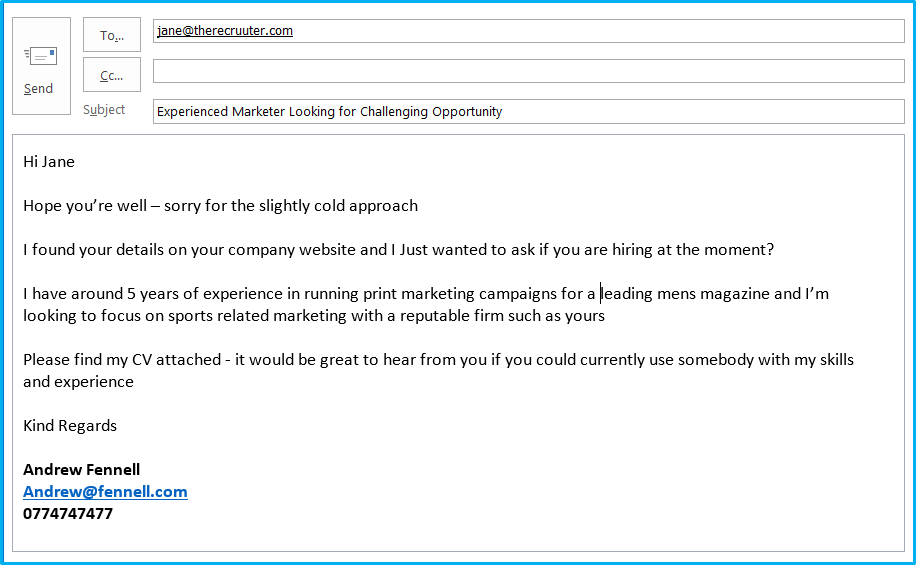Nonprofit Jobs
If you are feeling frustrated from spending all day trawling the job sites, applying to hundreds of job adverts and not getting any responses … Then maybe it’s time for you to try getting a job before it’s advertised…
So how do you get a job before it’s advertised?
When faced with the challenge of how to get a job? The majority of us will hit the job websites – and rightly so; it’s a tried and tested method of landing jobs.
But one big disadvantage of applying for jobs you find advertised on job websites, is that they are highly visible and therefore there is an awful lot of competition for them.
Take a look at this job advert below that I found as an example – it’s only been online for a few days and there has already been 73 applications... if you were to apply now, you would be 1 of 74 potential candidates – not great odds.
So how do you beat the crowds and get a job before it’s advertised?
By making speculative applications – simply searching out suitable companies and asking them if they are hiring.
But if you want to be successful landing jobs this way, there are a few things you should know beforehand…
Firstly there are pros and cons of making speculative applications….
Pro – You can side step the competition and find job vacancies before they are advertised
Con – Not every company you approach will be hiring so response and success rates can sometimes be low
Pro – It only takes one positive response to land a job
Secondly there a few steps you should follow to get the best from your applications… The following 4 steps will show you how to get a job through speculative emails.
1. Find LOTS of suitable organizations/companies to approach
Sending speculative applications really is a numbers game – you don’t know if the companies that you’re approaching are hiring or not, so it’s best to contact as many as possible to ensure that you get some positive responses.
Run a Google search for the type of companies who employ people in your desired role and make a long list of their websites. You don’t have to apply for them all in one sitting – For example you could make a list of 50 and contact 10 per day over the course of 5 days.
2. Find the best people to contact about jobs at the organization
If you’re contacting employers to ask about their vacancies then you need to make sure that your emails are reaching decisions makers. It probably won’t be good enough to just message the general info@organization.org email address or use their contact form because those emails will likely go to customer service reps or receptionists who won’t be hugely interested in speculative job applications.
So who are the right people to contact? Big employers will usually have a recruitment or HR department to look after all of their hiring but very small firms will probably just handle it via the owner or Managing Director.
How do you find these people?
Search the organizations site: A lot of companies will have details of their recruitment staff and leadership teams on their website – they will usually be in the About Us or Contact Us pages but sometimes you will need to be delve a bit deeper.
Search on LinkedIn: If you can’t find a direct email address for somebody on the company site then search LinkedIn – if a company has full time recruitment staff then they will almost certainly be on LinkedIn.
Search for phrases like “recruitment” and “talent” along with the company’s name. You can filter the search to only include current employees of the firm to remove ex-employees from your search results (as shown below).
Once you have found the relevant person (or maybe a few people in a very organization) you can either message them directly via LinkedIn – or if they have an email address on their profile, you can use that to email them.
3. Send them a really compelling message
This person may not currently be advertising a suitable job for you and they will not be expecting your email so you need to make sure it’s very friendly, professional and gives them a good reason to get back to you.
- Use a subject line that will attract persuade them to open the email
- Address the person by name
- Focus on what you have to offer them (not what you want from them)
- Keep it short and sharp
- Make it look professional (with a proper signature etc.)
- Be extremely polite and friendly
- Attach your CV
Doing all of these things will increase your chances of getting a response from the recruiter – see the example below:
Time saving tip: Make yourself an email template with your basic opening, sign off and signature so that you don’t have to type everything out for each email – just copy and paste the template then add the specifics for each company you approach.
4. Follow up with non-responders
You may not get a response from every email you send first time – but don’t let that discourage you.
Follow up emails usually get a response so they are a great way to boost your success rate.
Keep a track of every email you send and when you sent it (ideally in our job application tracker spreadsheet or something similar) and if you haven’t heard from the recruiter within a few days then follow up with a friendly reminder email.
The easiest thing to so is simply forward your original email (this ensures your CV will be attached again) and politely ask if they’ve had the chance to read your first message.
Most recruiters are genuinely very busy people so sometimes they will just need a little nudge to respond to you.
You could also put a quick telephone call if you have the number but be careful not to pester – if you’ve attempted to contact somebody a few times and they still haven’t got back to you, then you are better off focusing your attention elsewhere.
Conclusion – How to get a nonprofit job before it’s advertised? Be pro-active and persistent
Whilst you won’t get results from every speculative email you send – it’s a great method of seeking out lesser known vacancies and side stepping the competition. The main benefit to remember is that you only need one positive response to land a job and even if you don’t, you will put yourself on the radars of lots of recruiters for future opportunities.
(The above content was provided by our partner http://standout-cv.com who has graciously offered for us to share this)




